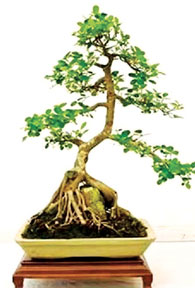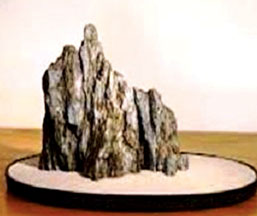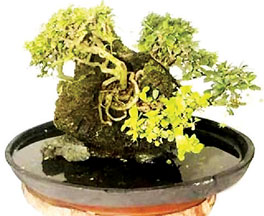Reflections 2013 ‘Living Images’
by Shanti Fernando
The Sri Lanka Bonsai Association will hold its annual exhibition
Reflections 2013 – Living Images at the National Art Gallery from
October 4 to 6 from 9.30 am to 6.30 pm. The opening ceremony and the
award presentation will be held at 11 am on October 4. The Ambassador
for Japan in Sri Lanka Nobuhito Hobo will be the chief guest.

 |
|
Attractive Bonsai
creations |
 |
The Association was formed to promote the art of Bonsai as a hobby in
Sri Lanka and has held a number of successful exhibitions in the past.
One of the main aims of Bonsai is to stimulate friendship and bring
peace through the common bond of love and beauty.
Suiseki and Bonsai
The artistic and poetic combination of Suiseki and Bonsai creates a
true work of art. The combination adds life to the Suiseki and Strength
to the Bonsai. And to both, a sense of timeless beauty is added. Suiseki
and Bonsai are important to each other. Suiseki represents a taste of
waterside in a condensed way, just as Bonsai represents forests and
groves in a pot.
What is Bonsai? Bonsai (bon-tray and sai-tree) is a tree in a shallow
tray. It is a living art which needs horticultural attention and is a
miniature replica of a tree in nature. What is Suiseki? Suiseki
(sui-water and seki-stone) is the Japanese name for miniature, naturally
formed stones that have the power and beauty to suggest a scene from
nature or object closely associated with nature.
They are also known as ‘Viewing Stones’ and ‘Scholar Stones'.The
Suiseki is the comprehension and the appreciation of nature through a
stone, resulting from nature. It is the study and enjoyment of naturally
formed stones as objects of beauty. The art of Suiseki involves the
collection, preparation and appreciation of unaltered naturally formed
stones. These stones are found in mountain streams, on windblown
deserts, along ocean beaches – anywhere that nature may have deposited
or shaped them.
Suiseki must have the five factors such as shape, material, colour,
texture, and age.
The shape should be a reflection of something in nature. The material
should be hard and dense, and it is better if it can maintain a moist
look after watering.
Black, brown and purple coloured stones are preferred. In addition,
if the fine texture has natural holes, unevenness, folds and lines,
these too add to the beauty of a Suiseki.
And “aged” stone is highly valued. The most important aspect of a
Suiseki is its ancient look. Suiseki is popular where the interest in
Bonsai has flourished. The reason for the fascination of Suiseki lies in
its physical beauty. uiseki and Bonsai should be in harmony and its
combination should enhance the feeling and aesthetics of each other. It
should always follow nature, reflect the spirit of its full-size
counterparts and suggest natural forms with simplicity. |

